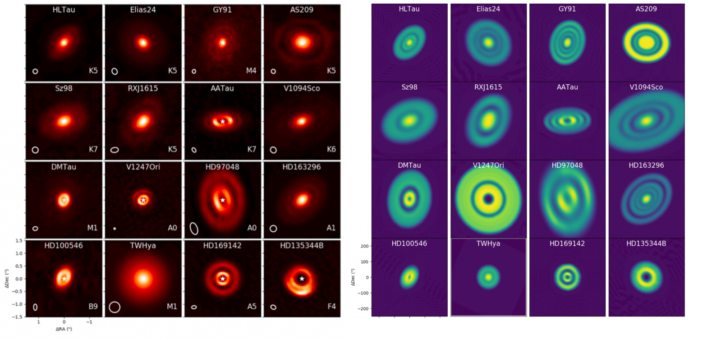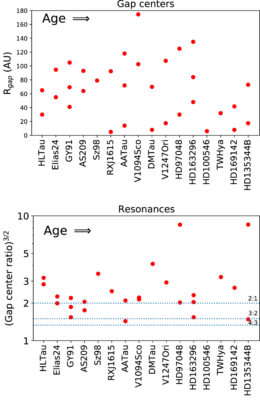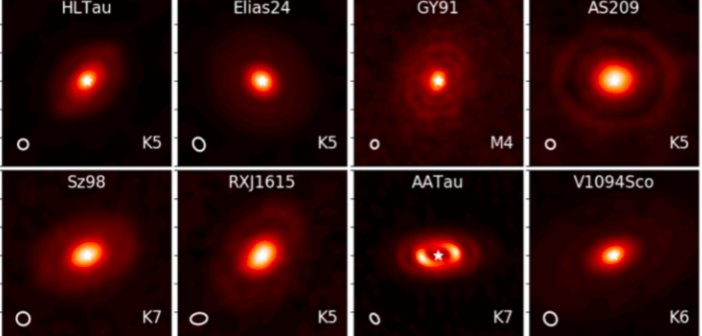Editor’s note: Astrobites is a graduate-student-run organization that digests astrophysical literature for undergraduate students. As part of the partnership between the AAS and astrobites, we occasionally repost astrobites content here at AAS Nova. We hope you enjoy this post from astrobites; the original can be viewed at astrobites.org.
Title: Protoplanetary Disk Rings and Gaps Across Ages and Luminosities
Author: Nienke van der Marel, Ruobing Dong, James di Francesco, Jonathan P. Williams, John Tobin
First Author’s Institution: Herzberg Astronomy & Astrophysics Programs, National Research Council of Canada
Status: Published in ApJ
If you’re well-versed in exoplanets (or even the formation of your own planet), you may be familiar with the term protoplanetary disk. These objects are disks of gas and dust surrounding a fairly newborn star, although newborn here means up to several million years old. Interestingly, images of protoplanetary disks captured by astronomers reveal gaps in the disks — or rather, separate rings of material, depending on your perspective. These types of disks were once expected to be completely smooth, so why are we seeing gap-like features in essentially all resolved images of them?

Figure 1: Left: Continuum emission for the disk sample. The beam size is shown in the lower left corner with the spectral type of each star in the right. HL Tau, TW Hya, and V1247 Ori, which had higher resolution, have been reduced to reflect the 20-AU beam size of the other images in order to make them comparable. Right: Enhanced image representations for each disk, which were used in the analyses. Gaps have been made easier to see using a variety of unsharp masking techniques. Transition disks are RXJ 1615, AA Tau, DM Tau, V 1247 Ori, HD 97048, HD 100546, TW Hya, HD 169142, and HD 135344B. [Adapted from van der Marel et al. 2019]
Before they can answer this question, the authors first determine each star + disk’s luminosity and use this information to age each star with model evolutionary tracks. The resulting age range gave them a way to classify their disks as older or younger. They also determined approximate gap locations and sizes via a type of intensity profile fitting, which essentially models the light coming from the star + disk in each image (where there is a gap, there is less light detected, etc.).
Searching for Answers

Figure 2: Gap properties for each disk. Each red dot represents a gap in the corresponding disk, with the disks sorted by increasing age. The gap center radius is raised to the 3/2 power, to mimic orbital resonance ratios. [Adapted from van der Marel et al. 2019]
the data — any correlations between the stars’ properties and the disk properties that may point to an origin story. Figures 2 and 3 show these chosen parameters … as well as the obvious dearth of trends. The only visible trend seems to be the decrease in outermost ring radius for the four oldest stars when compared to the rest of the sample (see Figure 3, bottom). This sure does make it hard to imagine a common mechanism responsible for the gaps.
Two of the most common theories for gaps within disks are 1) planets and 2) stuff freezing. Certain compounds are present in the disk, and there should be a point away from the star where the temperature becomes just right for those compounds to freeze into ice crystals. This is called the snow (or frost) line. At that snow line, it is thought that as these crystals all form together, they may stick to each other and the disk’s dust, which could clear out some space and turn into the gaps we see.
The authors looked to 5 different molecules in order to test this hypothesis: N2, CO, CH4, CO2, and NH3. This is the “stuff” we were talking about freezing. They determine the location of each respective snow line for each star and find that these locations don’t seem to have anything to do with the gaps — there are a few instances where the gap and snow line overlap, but it does not seem to be a systematic trend. So it seems the snow line scenario is a no-go.
Planetary formation is another story. It is thought that as planetesimals accrete surrounding disk material, a gap forms as it carves out its orbit. The authors state that they simply don’t have enough information to disprove or support this theory. Neptune-mass planets are currently undetectable and only one disk (HD 163296) in the sample has been suspected of having a planet. They do note however that one model of planet formation (cold-start model) would allow for giant-planet formation at the location of many of the observed gaps. So, planet formation is still a possible culprit.

Figure 3: Additional gap properties across ages and luminosities, with each red dot representing a gap. [Adapted from van der Marel et al. 2019]
So What Do We Know?
The only solid correlation present in the sample is that the outer disk ring is much closer in for the four oldest stars — i.e., the older disks are smaller in diameter. In that case, it seems we are missing some outer rings. So maybe the outer rings dissipate faster than the inner rings (due to drag forces or radiation pressure). Either that, or these outer dust grains accrete to become planetesimal sized and are therefore undetectable at the observed wavelengths.
Although the authors didn’t find the origin story they were looking for, they can say a few things with certainty. The lack of trends in their data show that disk gaps are diverse and their presence is largely independent of stellar properties, like spectral type or age. They also found that snow lines don’t have anything to do with the gaps we observe, but planets very well might. And last but not least, transition disks seem to host these features in the same manner as the truly protoplanetary disks, implying that they evolve in the same way, even if we don’t know what that way is. This is actually quite a big step in the right direction. These clues get astronomers one step closer to to closing the gap on … gaps.
About the author, Lauren Sgro:
I am a PhD student at the University of Georgia and, as boring as it may sound, I study dust. This includes debris disk stars and other types of strange, dusty star systems. Despite the all-consuming nature of graduate school, I enjoy doing yoga and occasionally hiking up a mountain.

2 Comments
Pingback: AAS Nova – New
Pingback: Reinterpreting Planet-Driven Gaps